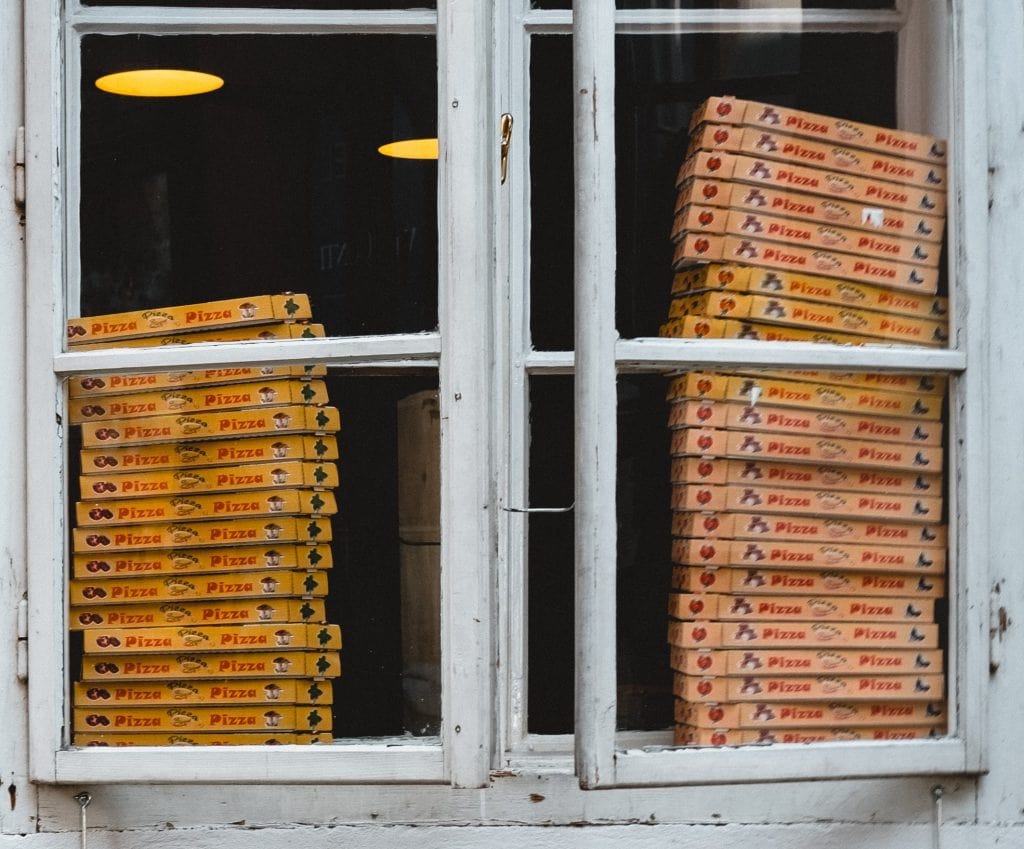How foodservice operators can replace plates with packaging.
By Pelican Consultant Emma Scott
4 minute read
Key takeaways:
Restaurants and cafes are still relying heavily on delivery services and meal kits. Packaging for these services is a great opportunity to promote your brand. Ensure you follow a few fundamental design rules to ensure your packaging is both practical and eye-catching.
During lockdown my favourite café, like many, changed its business model to move into the takeaway market. They installed a pizza oven and, from a socially safe distance, allowed customers to pick up freshly made pizzas rather than eat inside.
This particular café is known for its contemporary aesthetic. Food is usually presented on quirky, mismatched crockery and set on tables adorned with succulents and Himalayan salt lamps. I was therefore a little disappointed that my pizza arrived in a plain cardboard box. At the very least it struck me as something of a missed opportunity in terms of branding.
I also recently read about how Elite Bistros have come up with a clever way to survive lockdown; producing a full menu of dishes in kit form available for national delivery. One was ordered by food critic Jay Rayner who reviewed it for his column in The Guardian. The food received a glowing review from the Masterchef regular, but like me, he had issues with the packaging:
“Each dish is made up of bagged parts, all of them in-turn, in a sealed bag. My dozen dishes had at least 60 elements. All that plastic is recyclable though some of it, being sauce-smeared, is unlikely to be eligible.”
It then occurred to me; these businesses, and no doubt countless others, have never had to give packaging a second thought before.
Restaurants and cafes are now relying heavily on delivery services and meal kits, and it’s likely this new way of enjoying restaurant-quality food is here to stay. So how do you go about packaging a product that’s previously only been plated?
Where to start?
From the choice of materials to the graphics, colours and fonts, there’s a lot to consider, so whether you’re in the food industry or not, starting packaging design from scratch is a daunting prospect.
Regardless of what you need to package, there are a few questions you need to ask yourself first.
- What are you packaging?
In other words, what product are you selling and what qualities might influence your packaging choices? Consider the size of the product, and how fragile it is. If you’re delivering a food product, temperature will also be a consideration. Do you need a material that helps keep your product hot or cold? The answer to these questions will help you make practical choices in terms of outer packaging materials and internal layers.
- Where are you selling?
Another practical consideration. Will your product be on supermarket shelves, or be sold online? In the case of foodservice products, are you delivering directly to customers, or will they collect from you? The shelf impact of your packaging probably won’t be of much concern if your product is only available online, but the packaging will need to be sturdy enough to prevent damage in transit.
Once you’re clear about the shape, size and materials needed to package your product effectively you can move onto the creative elements, and for this you need to ask another question:
- Who is your customer?
This will inform the look of your packaging because it needs to appeal to your intended consumer. Is your product aimed at young consumers or an older demographic? Are your customers environmentally conscious? What is their budget? It’s important to know who that consumer is before you start the design process.
Next, think about how your branding will be reflected in your packaging design.
Make sure you know the CMYK values or Pantone Matching Values (PMS) colours needed, have access to the correct fonts and have a vector file of your logo ready. Not only will these elements ensure continuity across all your brand assets, it will make the process smoother when I comes to getting your packaging printed.
It’s also important to remember that, depending on your industry, there might be elements you’re legally required to include on your packaging. For example, barcode, nutrition information, association marks, expiration dates, batch numbers. Make sure you leave room for them.
Even if such information is not a legal requirement, no-one wants to see a repeat of the Pret incident, in which a teenager died because there was no allergy information on the packaging of a baguette which contained sesame.
Other design considerations include written copy – anything from the name of your product to marketing copy. Do you need to include instructions for use or preparation? Make sure there’s space to clearly display all the information your customer needs.
Sustainability matters to your customer
For most products it is possible to at least ensure packaging materials are easy to recycle, but if you’re also entering the growing meal-kit sector, packaging presents a unique challenge. The ingredients must of course be hygienically packed, which often means using flexible plastics. These are not widely recycled and, as Mr Rayner rightly points out, even rigid plastics are likely to be rejected if contaminated with food waste.
Carefully think about how individual components can be posted in as few packages as possible to minimise waste.
A final thought
While packaging is primarily about practicality, like all good design it should tell a story. Pelican are expert storytellers and can help bring your brand to life through your packaging. For more information or advice, call us today.
Pelican Communications is a specialist in the environment & CSR, food, packaging & logistics and trade association sectors and offers a range of services such as strategy, design, content creation, public relations and people development. Contact us for marketing and communications expertise.
